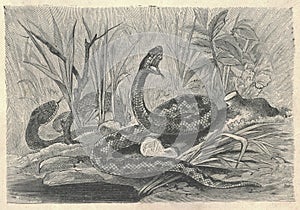- Price: 1$
- Size Facebook: 1702 x 630 px
- Size Twitter: 1500 x 500 px
- Size LinkedIn: 1128 x 191 px
More Facebook, Twitter and LinkedIn Cover Photos
Cover photo info
- Photo title: Antique engraved illustration of the common viper. Vintage illustration of the common viper. Old engraved picture of the
- Author: Romannerud
- Cover photo description:
- Antique engraved illustration of the common viper. Vintage illustration of the common viper. Old engraved picture of the common viper. Vipera berus, the common European adder or common European viper, is a venomous snake that is extremely widespread and can be found throughout most of central and eastern Europe and as far as East Asia. Known by a host of common names including common adder and common viper, adders have been the subject of much folklore in Britain and other European countries. They are not regarded as especially dangerous the snake is not aggressive and usually bites only when really provoked, stepped on, or picked up. Bites can be very painful, but are seldom fatal. The specific name, berus, is New Latin and was at one time used to refer to a snake, possibly the grass snake, Natrix natrix. The common adder is found in different terrains, habitat complexity being essential for different aspects of its behaviour. It feeds on small mammals, birds, lizards, and amphibians, and in some cases on spiders, worms, and insects. The common adder, like most other vipers, is ovoviviparous. Females breed once every two or three years, with litters usually being born in late summer to early autumn in the Northern Hemisphere. Litters range in size from three to 20 with young staying with their mothers for a few days. Adults grow to a total length & x28;including tail& x29; of 60 to 90 cm & x28;24 to 35 in& x29; and a mass of 50 to 180 g & x28;1.8 to 6.3 oz& x29;. Three subspecies are recognized, including the nominate subspecies, Vipera berus berus described here. The snake is not considered to be threatened, though it is protected in some countries.
- Image ID:262024281
- Views:0
- Downloads:0
Keywords for Facebook, Twitter and LinkedIn timeline photos
1800
1800s
19th
adder
age
aged
ancient
animal
antique
antiquity
archival
archive
art
artwork
book
c19th
century
cultural
culture
drawing
fauna
graphic
heritage
historic
history
illustration
image
natural
nature
old
picture
predator
reptile
snake
vertebrate
vintage
viper
viperidae














